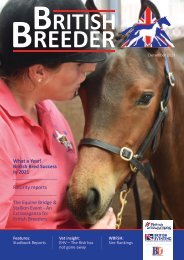British Breeder Magazine Feb 2020
Includes industry news, profiles and interviews plus detailed list of stallions presented at the British Breeding Stallion Event.
Includes industry news, profiles and interviews plus detailed list of stallions presented at the British Breeding Stallion Event.
Create successful ePaper yourself
Turn your PDF publications into a flip-book with our unique Google optimized e-Paper software.
Feature - VET INSIGHT
Is ovum pick up (OPU),
the future of horse breeding?
In the past decades there have been
tremendous advances in equine
breeding technology. Most mares
are now inseminated via artificial
insemination (AI) which not only
reduced the chance on transmitting
diseases and breeding injuries but also
made stallions available all over the
world. Especially the introduction of
frozen semen facilitated distribution
of semen and availability of stallions’
genetics even after his death. Another
big change has been the introduction of
embryo transfer (ET). With ET we refer
to the technique where an embryo is
flushed out of the uterus of a biological
dam (ET-donor) and transferred into
the uterus of a recipient mare. This
happens 7 or 8 days after insemination
of the donor mare. The recipient will
carry the embryo to term and raise
the foal as if it was her own. Donorrecipient
mare synchronisation, i.e.
both mares ovulated around the same
time, is paramount for the success
of ET. This will guarantee that the
transferred embryo will find a similar
uterine environment, essential for
embryo survival. ET has several
advantages: (1) it allows the mare to
produce offspring whilst continuing her
sportive career, (2) produce offspring of
mares with fertility issues, (3) produce
multiple embryos per season.
In recent years we have gone a
step further in applying assisted
reproductive technologies with
the introduction of test-tube foals
produced by a combination of two
techniques; Ovum Pick Up (OPU) and
Intracytoplasmic Sperm Injection
(ICSI). OPU, also known as oocyte
aspiration, is the procedure where
follicles are aspirated in order to
recover the oocyte (egg or ovum) they
contain. Women undergoing IVF require
multiple hormone injections prior
the procedure. However, in mares no
hormonal stimulation is needed. Before
scheduling an OPU-appointment, the
ovaries of the mares are assessed at
home to determine if she is a suitable
candidate. The ideal moment to
perform the procedure is when the
mare has a minimum of 15 follicles of
1cm or larger. If there are not enough
follicles present during this scan, the
ovaries are reassessed 3-4 weeks later
to allow enough time for follicular
growth. Unfortunately, oocytes are too
small (0.125 – 0.15mm)to visualise via
ultrasound. Therefore, the follicles,
which contain the oocytes, are
visualised by inserting an ultrasound
probe, equipped with a needle guide,
into the vagina.
74 | BRITISH BREEDER
The ovary is then grasped via the
rectum and held against the vaginal
wall. The fluid of each follicle is
aspirated and subsequently flushed
several times to enhance oocyte
recovery. After aspiration of all visible
follicles, the recovered fluid is filtered
and searched for the presence of
the oocytes. The oocytes are then
transferred into a transport medium
and shipped to a specialised lab,
where they are placed in a maturation
medium for 24h. This is because the
recovered oocytes are not yet ready
to be fertilised. During the normal
cycle of the mare, this maturation
happens while the follicle grows. The
maturation medium contains the same
kind of hormones that are present in
the follicular fluid. After the 24h of
incubation in the maturation medium,
the oocytes are assessed under the
microscope to evaluate whether or not
they have successfully matured. Only
matured oocytes will be fertilised.
Fertilisation in the lab is done by a
technique called Intracytoplasmic
Sperm Injection (ICSI) in which a single
spermatozoon is injected into the
oocyte. The oocyte is then transferred
into another medium to promote
the development into an embryo.
This development takes between 7-9
days. The fertilised oocytes that have
successfully developed into an embryo
will then be frozen and stored into
liquid nitrogen and shipped back to
the clinic. The frozen embryo can be
thawed and transferred at any time
during the breeding season when there
is a suitable recipient mare available.
OPU-ICSI has many advantages. Some
infertile mares fail to produce a viable
embryo for ET. Most common reasons
for this are pathology of the oviducts,
chronic uterine infections, cervical
defects, or hormonal imbalances.
These mares might lend themselves to
OPU and ICSI, as with this procedure
Dr Kaatje Ducheyne, PhD, MVSc, DipECAR, MRCVS
Sussex Equine Hospital / 01903 883050
we completely circumvent the mare’s
reproductive tract and transfer the
early embryonic development into the
laboratory. Other common candidates
for OPU-ICSI are competition mares.
Although ET allows the mare to
produce offspring without the need
of carrying the foal herself, it is hard
to plan the procedure into a busy
competition calendar. This is because
the mare needs close monitoring
of her reproductive cycle in order
to determine the optimal time of
insemination, and then the embryo
needs to be flushed out one week
later. For those mares OPU can be
a good option since it is performed
during a single visit to the clinic.
Another benefit of OPU for competition
horses is that there is no hormonal
treatment required. OPU-ICSI is further
used in cases of stallion infertility or
to optimise the use of expensive or
limited stocks of frozen semen. One
0.5ml straw of frozen semen can,
depending on the quality, be used for
3- 5 ICSI sessions. Furthermore, since
ICSI-embryos are frozen, there is no
pressure to synchronise the donor and
the recipient mare. Frozen embryos
can be transferred at your convenience
and allow planning when the foal
should be born. Frozen ICSI-embryos
are now often sold on auctions.
Additionally, ICSI offers a chance to
produce offspring in case of sudden
death, as long as the ovaries are swiftly
removed, and transported to a facility,
where the follicles can be aspirated.
All this will have a great influence on
horse breeding and will change the
conditions under which frozen semen
is sold. Until recently, UK breeders
needed to go to the continent for the
OPU procedure. Since autumn 2019
however, Sussex Equine Hospital is
offering this procedure as the only
hospital in the UK.
In summary, ET and OPU-ICSI have
created new opportunities in horse
breeding but deciding what is the
best option for your mare needs to
be decided on an individual basis. No
matter what option you choose, we
wish you all the best of
luck for this year’s
breeding
season.















